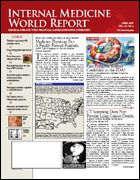Normal-Weight Obesity: New Syndrome Tied to CVD Risk
Consider Fat Mass on Top of BMI
Women who are considered to be normal weight based on their body mass index (BMI) could still be at risk for obesity and cardiovascular disease (CVD) if their body fat levels are too high.
Nutr Metab Cardiovasc Dis
Last year, Antonino De Lorenzo, MD, of the University of Tor Vergata in Rome, and colleagues discovered a syndrome that they called normal-weight obese (NWO) to describe women with a normal weight as measured by BMI but with body fat >30% of their total body weight (. 2006; 16:513-532).
Am J Clin Nutr
The same investigators conducted the current study (. 2007; 85:40-45) to evaluate differences in cytokine and lipid levels in 20 women with NWO, 20 overweight women (BMI >25 kg/m2) who also had >30% fat mass, and a control group of 20 normal-weight women (BMI <25 kg/m2) with a fat mass <30%. All the women were 20 to 32 years old, and none had symptoms of hypertension or CVD at baseline.
Blood samples were obtained between days 8 and 12 of the preovulation phase. Analysis showed that while lipid levels in the NWO group were similar to those in the controls, levels of certain proinflammatory cytokines—including interleukin (IL)-1, IL-6, and tumor necrosis factor (TNF)-α—were closer to those of the overweight women (Table).
Thus, although women with NWO syndrome were not overweight, their CVD risk was still increased because of their elevated levels of the proinflammatory cytokines that contribute to the development of CVD, atherosclerotic processes, and insulin resistance. This “early inflammatory state” could be a significant indicator of their future risk for obesity, CVD, and the metabolic syndrome.
Investigators also determined that plasma cytokine levels correlated with the percentage of fat mass in the NWO and overweight groups. This would jibe with previous research suggesting that TNF-α, IL-1, and IL-2 are produced and secreted by adipose tissue.
They concluded that the use of anthropometric measures such as BMI may misclassify obesity, and that an assessment of fat mass percentage and body fat distribution may also be needed. These additional measures may be particularly important in women with NWO, since based on their weight and lipid profile, they would be unaware that they were at risk for obesity-related diseases.
